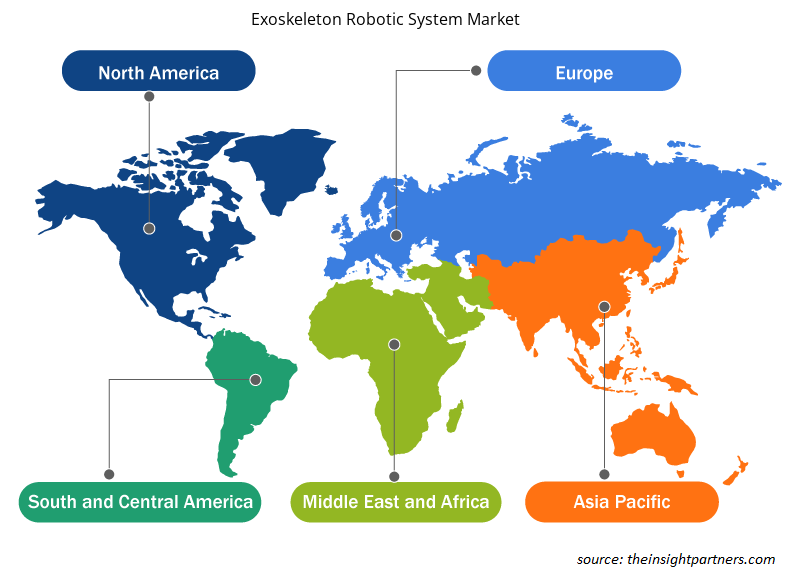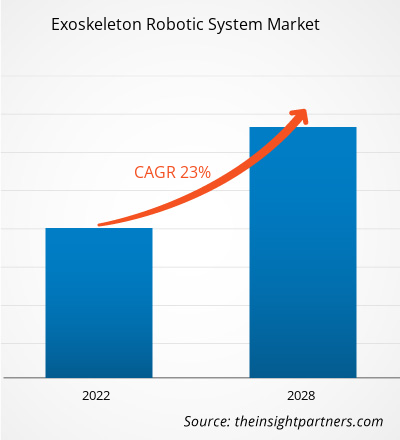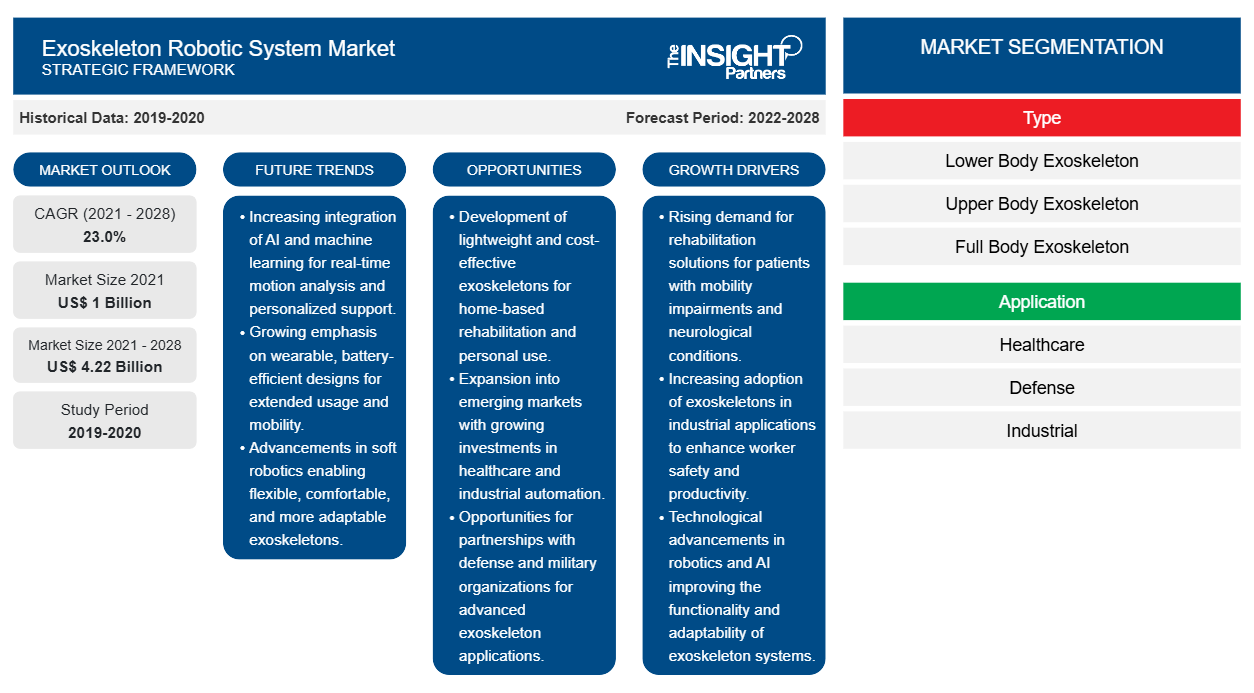من المتوقع أن ينمو سوق أنظمة الروبوتات الهيكلية الخارجية من 1،001.14 مليون دولار أمريكي في عام 2021 إلى 4،224.63 مليون دولار أمريكي بحلول عام 2028؛ ومن المتوقع أن ينمو بمعدل نمو سنوي مركب قدره 23.0٪ من عام 2022 إلى عام 2028.
نظام الروبوت الهيكلي الخارجي هو نوع من أنظمة التعاون بين الإنسان والروبوت. تعتبر الهياكل الخارجية الروبوتية وحدات روبوتية يمكن ارتداؤها يتم التحكم فيها بواسطة لوحات كمبيوتر لتشغيل نظام من المحركات أو الميكانيكا الهوائية أو الرافعات أو الهيدروليك لاستعادة الحركة. ينمو سوق نظام الروبوت الهيكلي الخارجي بسبب ارتفاع حالات السكتة الدماغية واضطرابات الجهاز العضلي الهيكلي وزيادة المبادرات الاستراتيجية من قبل اللاعبين في السوق.
رؤى السوق
ارتفاع معدل الإصابة بالسكتة الدماغية واضطرابات الجهاز العضلي الهيكلي يدفع نمو السوق
تظل السكتة الدماغية مرضًا يثير قلقًا كبيرًا على الصحة العامة، على الرغم من التقدم في الصناعة الطبية. ووفقًا لجمعية السكتة الدماغية الهندية، فقد زاد معدل الإصابة بالسكتة الدماغية في الهند بنحو 100% على مدى العقود القليلة الماضية. وعلاوة على ذلك، يعاني نحو 1.8 مليون شخص في الهند من السكتة الدماغية سنويًا، ولا يمكن إلا للعلاج المبكر أن يقلل من معدلات الإصابة والوفيات. وعلى الرغم من أن تزايد معدل الإصابة بهذا المرض غير المعدي يهدد السكان بشكل أكبر، إلا أن علاج السكتة الدماغية وإعادة التأهيل لا يزالان غير متطورين في البلاد. ووفقًا لمراكز السيطرة على الأمراض والوقاية منها، يصاب أكثر من 795000 شخص في الولايات المتحدة بسكتة دماغية كل عام، ومن بينهم نحو 610000 حالة سكتة دماغية أولى أو جديدة. علاوة على ذلك، تعد السكتة الدماغية خامس أعلى سبب للوفاة في الولايات المتحدة، حيث تسببت في 147810 حالة وفاة في عام 2018. وبشكل عام، كان هناك ما يقدر بنحو 460 ألف سكتة دماغية في الولايات المتحدة في عام 2019 (ثلثاها كانت إقفارية)، و190 ألف حالة وفاة مرتبطة بالسكتة الدماغية، و3.83 مليون سنة حياة معدلة للإعاقة بسبب السكتة الدماغية. لذلك، أدى ارتفاع حالات السكتة الدماغية إلى زيادة الطلب على نظام الروبوت الهيكلي الخارجي لإعادة تأهيل مرضى السكتة الدماغية للمساعدة في تحسين نوعية الحياة.
علاوة على ذلك، تؤثر اضطرابات الجهاز العضلي الهيكلي على قدرة الفرد على الحركة. ومن المتوقع أن يؤدي الانتشار المتزايد لاضطرابات الجهاز العضلي الهيكلي، مثل التهاب الأوتار وهشاشة العظام وهشاشة العظام وإصابات أسفل الظهر، إلى زيادة الحاجة إلى أنظمة الروبوتات الخارجية. ووفقًا لمنظمة الصحة العالمية، فإن أمراض الجهاز العضلي الهيكلي تؤثر على حوالي 1.71 مليار شخص على مستوى العالم، وآلام أسفل الظهر هي السبب الرئيسي للإعاقة في 160 دولة. تساعد أنظمة الروبوتات الخارجية هذه المرضى في إدارة حالتهم واستعادة حركتهم، وبالتالي تحسين نوعية حياتهم بشكل عام. وبالتالي، أدى الانتشار المتزايد للسكتة الدماغية واضطرابات الجهاز العضلي الهيكلي إلى زيادة استخدام أنظمة الروبوتات الخارجية لإعادة التأهيل.
قم بتخصيص هذا التقرير ليناسب متطلباتك
ستحصل على تخصيص لأي تقرير - مجانًا - بما في ذلك أجزاء من هذا التقرير، أو تحليل على مستوى الدولة، وحزمة بيانات Excel، بالإضافة إلى الاستفادة من العروض والخصومات الرائعة للشركات الناشئة والجامعات
-
احصل على أهم اتجاهات السوق الرئيسية لهذا التقرير.ستتضمن هذه العينة المجانية تحليلاً للبيانات، بدءًا من اتجاهات السوق وحتى التقديرات والتوقعات.
التقدم التكنولوجي المتزايد والاستثمارات المتزايدة
تتغير اتجاهات صناعة الرعاية الصحية بشكل كبير بسبب التطورات والابتكارات التكنولوجية المستمرة، مما يعزز خدمات الرعاية الصحية وجودة الرعاية. يسعى العديد من اللاعبين في سوق أنظمة الروبوتات الخارجية العالمية جاهدين للحصول على حصة سوقية أكبر، تليها استثمارات متزايدة في أنظمة الروبوتات الخارجية على المستوى العالمي. على سبيل المثال، في أبريل 2022، أكملت شركة تصنيع الهياكل الخارجية - RoboCT Technology Development Co. - جولة تمويل من الفئة A + بقيمة 15.7 مليون دولار أمريكي (100 مليون يوان صيني). توفر شركة RoboCT ومقرها هانغتشو بالصين للمعاقين وكبار السن ومؤسسات إعادة التأهيل الطبي أجهزة إعادة تأهيل ذكية وتكنولوجيا روبوتية مع تحليل البيانات والحوسبة السحابية. بالإضافة إلى ذلك، من المتوقع أن يؤدي الارتفاع في أنشطة البحث والتطوير من قبل الشركات إلى تسريع تطوير أنظمة متقدمة لمجالات تطبيق متنوعة مثل الرعاية الصحية والكيميائية والدفاعية والتجارية. تمتلك الشركات أيضًا حقوق التكنولوجيا والملكية الفكرية الخاصة بها التي تساعدها في الحفاظ على حصتها في السوق. على سبيل المثال، تشارك شركة RoboCT Technology Development Co. في البحث والتطوير لتكنولوجيا الهياكل الخارجية في العديد من المجالات، مثل الترفيه والصناعة والرياضة. تقدمت شركة RoboCT بطلب للحصول على أكثر من 100 حقوق ملكية فكرية وحصلت على أكثر من 20 جائزة في مجالات مختلفة.
كما من المتوقع أن تعمل التطورات التكنولوجية المستمرة على تعزيز نمو السوق. ومن المتوقع أن يكمل التبني المتزايد للذكاء الاصطناعي وإنترنت الأشياء في تطوير أنظمة الروبوتات الخارجية الذكية نمو السوق. على سبيل المثال، طورت شركة German Bionic نظامًا روبوتيًا خارجيًا قائمًا على الذكاء الاصطناعي أضاف رفيقًا ذكيًا للسلامة ومنصة سحابية للهياكل الخارجية. وبالتالي، من المرجح أن تحفز التطورات التكنولوجية المتزايدة والاستثمارات المتزايدة نمو سوق أنظمة الروبوتات الخارجية العالمية
رؤى مبنية على النوع
يتم تقسيم سوق أنظمة الروبوتات الهيكلية الخارجية، بناءً على النوع، إلى هياكل خارجية للجزء السفلي من الجسم، وهياكل خارجية للجزء العلوي من الجسم، وهياكل خارجية لكامل الجسم. احتل قطاع الهياكل الخارجية للجزء السفلي من الجسم أكبر حصة سوقية في سوق أنظمة الروبوتات الهيكلية الخارجية في عام 2021، ومن المرجح أن يكون قطاع الهياكل الخارجية للجزء العلوي من الجسم هو القطاع الأسرع نموًا خلال فترة التوقعات.
رؤى مبنية على النوع
يتم تقسيم سوق أنظمة الروبوتات الهيكلية الخارجية، بناءً على النوع، إلى هيكل خارجي للجزء السفلي من الجسم، وهيكل خارجي للجزء العلوي من الجسم، وهيكل خارجي لكامل الجسم. استحوذ قطاع الهيكل الخارجي للجزء السفلي من الجسم على أكبر حصة من السوق في عام 2021. ومن المتوقع أن يسجل قطاع الهيكل الخارجي للجزء العلوي من الجسم أعلى معدل نمو سنوي مركب بنسبة 23.6٪ خلال الفترة المتوقعة.
رؤى قائمة على التطبيق
بناءً على التطبيق، يتم تقسيم سوق أنظمة الروبوتات الهيكلية الخارجية إلى الرعاية الصحية والدفاع والصناعة. استحوذ قطاع الرعاية الصحية على أكبر حصة من السوق في عام 2021. ومن المتوقع أن يسجل القطاع الصناعي أعلى معدل نمو سنوي مركب بنسبة 23.6٪ خلال الفترة المتوقعة.
تتبنى الشركات في سوق أنظمة الروبوتات الهيكلية الخارجية بشكل كبير الاستراتيجيات العضوية وغير العضوية مثل عمليات الدمج والاستحواذ. فيما يلي أهم التطورات السوقية الأخيرة:
- في فبراير 2022، أعلنت شركة Hocoma أن مشروع SwissNeuroRehab Flagship سيحظى بدعم مالي من وكالة الابتكار السويسرية Innosuisse. يهدف مشروع SwissNeuroRehab إلى تطوير وتقييم نموذج جديد لإعادة التأهيل العصبي على طول سلسلة الرعاية، من المستشفى إلى المنزل، من خلال الجمع بين أفضل الأساليب الرقمية والتكنولوجية المتاحة لإنشاء برامج علاجية مبتكرة وفعالة مصممة خصيصًا لتلبية احتياجات المريض الفردية.
- في نوفمبر 2021، منحت إدارة الغذاء والدواء الأمريكية تصنيف الجهاز الرائد لبدلة ReWalk ReBoot Soft Exo-Suit لإعادة تأهيل السكتة الدماغية في المنزل. ReBoot عبارة عن بدلة خارجية تقويمية خفيفة الوزن تعمل بالبطارية تهدف إلى مساعدة الوظائف الحركية للأفراد الذين يعانون من ضعف وظيفة الكاحل بسبب الإصابات العصبية والسكتة الدماغية. إنه منتج شقيق لجهاز ReStore، الذي حصل على موافقة إدارة الغذاء والدواء الأمريكية في عام 2019 للاستخدام في بيئة إعادة التأهيل.
رؤى إقليمية حول سوق أنظمة الروبوتات الهيكلية الخارجية
لقد قام المحللون في Insight Partners بشرح الاتجاهات والعوامل الإقليمية المؤثرة على سوق نظام الروبوتات الهيكلية الخارجية طوال فترة التوقعات بشكل شامل. يناقش هذا القسم أيضًا قطاعات سوق نظام الروبوتات الهيكلية الخارجية والجغرافيا في جميع أنحاء أمريكا الشمالية وأوروبا ومنطقة آسيا والمحيط الهادئ والشرق الأوسط وأفريقيا وأمريكا الجنوبية والوسطى.

- احصل على البيانات الإقليمية المحددة لسوق أنظمة الروبوتات الهيكلية الخارجية
نطاق تقرير سوق أنظمة الروبوتات الهيكلية الخارجية
| سمة التقرير | تفاصيل |
|---|---|
| حجم السوق في عام 2021 | 1 مليار دولار أمريكي |
| حجم السوق بحلول عام 2028 | 4.22 مليار دولار أمريكي |
| معدل النمو السنوي المركب العالمي (2021 - 2028) | 23.0% |
| البيانات التاريخية | 2019-2020 |
| فترة التنبؤ | 2022-2028 |
| القطاعات المغطاة |
حسب النوع
|
| المناطق والدول المغطاة |
أمريكا الشمالية
|
| قادة السوق وملفات تعريف الشركات الرئيسية |
|
كثافة اللاعبين في سوق أنظمة الروبوتات الهيكلية الخارجية: فهم تأثيرها على ديناميكيات الأعمال
يشهد سوق أنظمة الروبوتات الهيكلية الخارجية نموًا سريعًا، مدفوعًا بالطلب المتزايد من المستخدم النهائي بسبب عوامل مثل تفضيلات المستهلك المتطورة والتقدم التكنولوجي والوعي الأكبر بفوائد المنتج. ومع ارتفاع الطلب، تعمل الشركات على توسيع عروضها والابتكار لتلبية احتياجات المستهلكين والاستفادة من الاتجاهات الناشئة، مما يؤدي إلى زيادة نمو السوق.
تشير كثافة اللاعبين في السوق إلى توزيع الشركات أو المؤسسات العاملة في سوق أو صناعة معينة. وهي تشير إلى عدد المنافسين (اللاعبين في السوق) الموجودين في مساحة سوق معينة نسبة إلى حجمها أو قيمتها السوقية الإجمالية.
الشركات الرئيسية العاملة في سوق نظام الروبوتات الهيكلية الخارجية هي:
- شركة لوكهيد مارتن
- شركة سايبرداين
- شركة باناسونيك القابضة
- شركة هوكوما ايه جي
- شركة ري والك للروبوتات
إخلاء المسؤولية : الشركات المذكورة أعلاه ليست مرتبة بأي ترتيب معين.

- احصل على نظرة عامة على أهم اللاعبين الرئيسيين في سوق نظام الروبوتات الهيكلية الخارجية
ملفات تعريف الشركة - سوق أنظمة الروبوتات الهيكلية الخارجية
- شركة لوكهيد مارتن
- شركة سايبرداين
- شركة باناسونيك القابضة
- شركة هوكوما ايه جي
- شركة ريوالوك للروبوتات
- شركة إكسو بايونيكس القابضة
- شركة باركر هانيفين
- شركة ميومو
- شركة بي تيميا
- شركة ألترجي
- شركة اينوفيز المحدودة
- التحليل التاريخي (سنتان)، سنة الأساس، التوقعات (7 سنوات) مع معدل النمو السنوي المركب
- تحليل PEST و SWOT
- حجم السوق والقيمة / الحجم - عالمي، إقليمي، بلد
- الصناعة والمنافسة
- مجموعة بيانات إكسل
التقارير الحديثة
شهادات العملاء
سبب الشراء
- اتخاذ قرارات مدروسة
- فهم ديناميكيات السوق
- تحليل المنافسة
- رؤى العملاء
- توقعات السوق
- تخفيف المخاطر
- التخطيط الاستراتيجي
- مبررات الاستثمار
- تحديد الأسواق الناشئة
- تحسين استراتيجيات التسويق
- تعزيز الكفاءة التشغيلية
- مواكبة التوجهات التنظيمية























 احصل على عينة مجانية ل - سوق أنظمة الروبوتات الهيكلية الخارجية
احصل على عينة مجانية ل - سوق أنظمة الروبوتات الهيكلية الخارجية